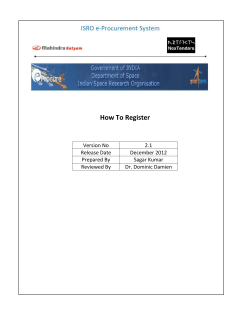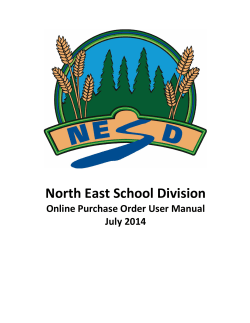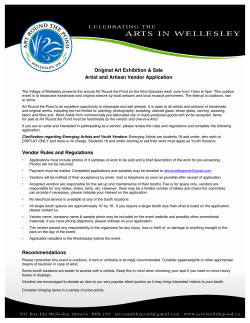
Document 237651
According to the State University of New York Fiscal and Accounting Procedures for Mandatory Student Activity Fee Programs (Page 5) the custodial and disbursing agent (Sub-Board I) must establish and maintain an encumbrance approval system. Encumbrance approval systems are commonly used in governmental and certain other not-for-profit accounting systems. I. Definition II. What is an encumbrance? An encumbrance is the first part of a three-part process for purchasing and paying for goods or services. (The other two processes are the Accounts Payable process and the Cash Disbursements process). An encumbrance is a special type of accounting transaction that anticipates a future expenditure. Funds are encumbered, or set aside, in a particular appropriation budgetary account for a specific future purchase. The document used to record an encumbrance is called a Purchase Order. What are the advantages of using an encumbrance approval system? There are several important advantages of using an encumbrance approval system. Pre-approval is the key! First, an encumbrance system requires that proper authorization must be obtained before a purchase takes place and before a financial commitment occurs. As discussed earlier in Chapter I, Introduction (Page 3) the officers of the student government/client have a fiduciary obligation to be fully informed regarding all aspects of their organization’s operations, and to act in the best interests of their organization. An encumbrance system enables the officers to fulfill this fiduciary obligation by informing them of a purchase before it takes place, and by giving them the opportunity to authorize the purchase in advance. The signatures on the Purchase Order insure that this authorization has taken place. Conversely, an encumbrance system also enables the officers to disallow or prevent a purchase from taking place, if they feel that the purchase would not be in the best interests of the organization, or if the purchase would not conform to the organization’s goals and objectives. Therefore, an encumbrance approval system is proactive rather than 29 reactive since the officers have the ability to approve, question, or if necessary, pre-empt a potential commitment of funds from taking place before a legal liability is incurred. Budgetary Constraints Officer Approval Second, an encumbrance approval system recognizes budgetary constraints. By insuring that the available balance in a budgetary account is sufficient to allow the purchase commitment, the organization is prevented from over-spending before the commitment takes place. If a budgetary account lacks sufficient funds to place the encumbrance, management can then take steps to adjust or revise its budgetary plan if it wishes to move forward with the purchase. Therefore, the fiscal integrity of the budget and management’s budgetary goals and objectives are not compromised or circumvented. Third, an encumbrance approval system places the authority and responsibility for spending at the proper level of management, namely, the chief officers of the student government/client. III. How does the encumbrance system work? First, the student government/client must enter a Requisition into the on-line accounting system (KVS). Please refer to the “KVS Tutorial” on our website (www.subboard.com/accounting) for instructions on how to enter a Requisition. Remember that the Requisition must be entered and approved before the purchase takes place and before incurring any fiscal commitment. Where will the check be sent? Full description of purchase Check Routing: It is important to indicate whether you wish the SBI Accounting Office to mail the payment to the vendor address or whether you wish to pick up the check. In the case of an advance payment, the check must be picked up in person at the SBI Accounting Office by a responsible person. All advances must be picked up and signed for at the SBI Accounting Office regardless of which check-routing option is indicated on the Requisition. Complete Description and Specifications: You must provide a complete description of the anticipated purchase. Think of answering the questions “what, when, where and why” when providing the description. If you are purchasing goods, you may use the Qty (Quantity), Unit and Unit Price columns if you wish. Remember that the information you 30 provide will be copied to the Purchase Order so it is better to provide more information rather than less. Estimate the total IV. Is this a valid appropriation account? Total: Enter a reasonably accurate estimate of the how much the purchase will cost. Since at this point the purchase has not yet occurred, an estimated amount is sufficient if you are unsure of what the actual cost will ultimately be. The estimated amount on the purchase order eventually will be adjusted to the actual amount when payment is made to the vendor. After a Requisition is entered into the accounting system, what happens next? After the Administrative Designee approves your Requisition, the SBI Accounting Office will review it to insure that all information is complete and accurate. We will check that the appropriation budgetary account on the form adequately reflects the nature and purpose of the anticipated purchase. If we determine that the appropriation budgetary account does not adequately correspond to the purchase, then we will “hold” the Requisition until the student government/client corrects the account. TIN form required If the appropriation budgetary account is valid, we will further review the nature of the anticipated purchase to determine if the vendor is subject to IRS “1099” regulations. If the SBI Accounting Office determines that the vendor is a “1099 vendor”, then IRS Form W-9 (or an acceptable substitute) must be completed and signed by the vendor. Sub-Board I uses a substitute Form W-9 which we call a TIN form (see Illustration 8). The SBI Accounting Office will send a TIN form to the vendor for completion unless the student government/client wishes to send a TIN form to the vendor themselves. Payment will not be made unless a valid Form W-9 or TIN form is received from the vendor. A “1099 vendor” needs to complete and submit a Form W-9 or TIN form only once. Once we have the signed TIN form from the vendor on file, it is valid for all future purchases made from that vendor, unless the tax status of the vendor changes. Is this a purchase of a fixed asset? If the vendor for this purchase is not subject to IRS “1099” regulations, no TIN from is required. The SBI Accounting Office will then review the description on the Requisition to determine if this is a purchase of a fixed asset, i.e. capital equipment or other depreciable property. If we Is this a “1099” vendor? 31 Capital Expenditure Requisition determine that this is a purchase of a fixed asset, we will attach a threepart Capital Expenditure Requisition (see Illustration 20) to the printed Purchase Order. The Capital Expenditure Requisition must be completed by the student government/client and returned to the SBI Accounting Office with the approved, completed Purchase Order at the time of payment. Please refer to Section XI, Fixed Asset System (Page 89) for a more complete description of procedures for the purchase of equipment and other depreciable property. Information entered into Accounting System Insufficient funds Purchase order printed Now the purchase can be initiated V. 24-hour turnaround time Once the SBI Accounting Office has completed the review of the Requisition, we will “release” the Requisition to a Purchase Order. If the account lacks sufficient funds to create the Purchase Order, a copy of the Requisition form is returned unprocessed to the student government/client. SUNY Fiscal Guidelines for Mandatory Student Activity Fee Programs require that the custodial and disbursing agent (Sub-Board I) must assure that budgetary amounts are not over-encumbered. The Requisition will be held to await further instructions from the student government/client. Upon receiving notification that the Purchase Order has not been processed because of insufficient funds, the student government/client should take steps to either adjust the budget to increase funds in the appropriation account, or to discontinue the process and cancel the purchase. Assuming that all procedures have been correctly followed, and the designated appropriation budgetary account balance is sufficient to allow creation of the Purchase Order, the SBI Accounting Office will print the Purchase Order and send it to the student government/client for authorization by the officers. After the officers have signed the Purchase Order, the purchase may be initiated by placing the order for goods, or, if applicable, negotiating a contract with the vendor for the services to be performed. You may use a photocopy of the approved Purchase Order to notify the vendor that the purchase has been properly authorized. In most cases, a reputable vendor will accept the Purchase Order as your promise to pay after the vendor has provided the goods or services. How long does the encumbrance process take? From the time the SBI Accounting Office receives the approved Requisition from the Administrative Designee, to the time the printed 32 Purchase Order is sent to the student government/client for authorization, the process normally takes no more than 24 hours. Therefore, your Purchase Order should be ready the next business day after we receive your approved Requisition from the Administrative Designee. This is assuming that the student government/client has correctly followed all procedures in completing the Requisition, and that the designated appropriation budgetary account has sufficient funds. There may be unusual circumstances when the SBI Accounting Office may need more time to process your Requisitions, e.g. if our computer system is down, if the volume of activity is unusually heavy, etc., but these instances are generally quite rare. VI. You must use the correct account number If I need to submit a Requisition, and the correct appropriation account does not have sufficient funds, can I encumber a different account that has sufficient funds? No. One of the purposes of maintaining budgetary accounts is to provide accurate financial information on the nature of operations. If encumbrances (and expenditures) are charged to the wrong account, budgetary information will be inaccurate and misleading. While it may be expedient to use an account that has sufficient funds (even if that account does not accurately reflect the nature and purpose of the purchase), the correct procedure is to prepare a budget adjustment to provide adequate funds in the correct appropriation budgetary account before entering a Requisition. VII. How does the SBI Accounting Office determine whether a vendor is subject to IRS “1099” regulations? IRS regulations According to the Internal Revenue Service (IRS), all payments for nonemployee compensation or miscellaneous income (i.e. payments to independent contractors or “1099” vendors) must be supported by IRS Form W-9, Payer’s Request for Identification Number and Certification. SubBoard I uses a substitute Form W-9 (see Illustration 8) that satisfies the IRS requirements for obtaining tax information from vendors who are to receive such payments. Sub-Board I must report all miscellaneous income paid to “1099” vendors to the IRS on Form 1099 in the event that payments to any such vendor exceed $600 in a calendar year. The IRS has published guidelines that Sub-Board I uses to determine which vendors are subject to 1099 regulations and must submit a TIN form. TIN forms will be required from vendors in these situations: 33 All rentals (equipment, machines, motor vehicles, etc.) All royalty payments All prizes and awards that are not for services rendered All physicians or suppliers or providers of medical or health care services All services rendered, including: Attorneys’ and accountants’ fees for professional services Fees paid by one professional to another, such as referral fees Payment for services, including parts or materials used to render the services, unless the person rendering the service is in the business of selling parts and materials Commissions paid to non-employee salespersons, subject to repayment but not repaid during the calendar year Payments to non-employee entertainers and speakers for services All co-sponsorships with non-exempt outside parties Exchanges of services between individuals in the course of their trade or businesses Employee or Independent Contractor? It may sometimes be unclear whether a vendor is an independent contractor or an employee. Sub-Board I follows the common law rules for determining whether an employer-employee relationship exists or whether a vendor is a bona-fide independent contractor. Because SubBoard I is liable to the IRS for any misrepresentation or reporting violations, if and when any unique judgements need to be made (in addition to what is listed above), Sub-Board I will make the determination. In order to insure compliance with IRS regulations, the following procedures must be followed: Please provide a sufficient description! When you enter a Requisition, the SBI Accounting Office will determine from the description you provide whether this vendor is subject to IRS “1099” regulations. Therefore, to avoid any confusion or delays, it is important that you provide a sufficient description so that we can make an accurate determination. If the SBI Accounting Office determines that this is a “1099” vendor, we will mail a TIN form to the vendor using the address you provide on the Requisition. Therefore, you must provide an accurate address when you submit the Requisition, even if the check is being picked up rather than mailed. To save time, we can fax the TIN form to the 34 Don’t forget to provide the vendor’s address! vendor if you provide us with the vendor’s fax number. If you wish, you may mail or fax the TIN form to the vendor yourself. If you do, you should indicate this on your Requisition, so that the SBI Accounting Office does not also send a TIN form to the vendor. When the vendor returns the completed TIN form to the SBI Accounting Office (either by mail or by fax), we will review the form to make sure it is valid. The vendor’s TIN number must be either a The vendor must provide a valid Tax nine-digit Social Security number or a nine-digit Federal Tax Identification number Identification number issued to the vendor by the IRS. The name of the vendor signing the TIN form or the name of the entity must match the name of the vendor on the Requisition. The vendor must correctly check off the appropriate Type of Payee on the TIN form. The SBI Accounting Office will not process payment to a vendor whose TIN form is incomplete, inaccurate or questionable. It is important that you enter your Requisitions at the earliest date possible to avoid any delays in payment. If the vendor does not return the TIN form by the date payment is due, one of two things will happen: The SBI Accounting Office will not process payment to the vendor until the vendor submits a valid TIN form, or The SBI Accounting Office will be legally required to withhold 31% of the payment to the vendor as backup withholding which must be paid to the Internal Revenue Service. Unless there is no alternative, the SBI Accounting Office will not deduct and remit backup withholding; rather, we prefer to delay payment to the vendor until they submit a valid TIN form. If the SBI Accounting Office determines that an employee-employer An employee must be paid through the relationship exists, and the vendor should be paid as an employee, the Payroll system! Requisition will be deleted and the student government/client must submit the proper employment forms. Please refer to Section X, Payroll and Personnel System (Page 71) for a more complete description on employment procedures. You may wish to notify your vendors that payment to them could be delayed or reduced if they do not complete and submit the TIN form on a timely basis. In addition, the IRS may assess a $50 fine to any vendor who does not provide a valid TIN form. Unless a vendor’s tax status changes, they need submit a TIN form only once. The SBI Accounting Office will maintain a file of completed TIN 35 forms received from vendors, and will do its best to check them on a consistent basis. VIII. What is a “prepaid expenditure”? Payments such as insurance premiums, maintenance agreements, subscriptions, etc. are usually paid in advance, and expire over time IX. Outstanding Purchase Order detail report X. Certain types of expenditures, such as annual, semi-annual or quarterly payments for equipment maintenance agreements, insurance premiums, magazine and periodical subscriptions, dues and memberships, etc., are considered prepaid expenditures if they exceed $100 per year. According to generally accepted accounting principles, expenditures of this type are recorded not as operating expenses, but rather as assets at the time of payment. This asset, called a prepaid expense, expires or decreases over the time period covered by the payment. The periodic amount of the decrease in the asset is recorded as an expense as the asset expires over time, so that at the end of the period covered by the initial payment, the value of the asset will be $0, and the full amount of the payment will have been recorded as an expense. Because of this special accounting requirement, Requisitions must have specific appropriation account numbers for payments of this type. (Please refer to Section III, Budgetary Control System (Page 9) for a more complete description on the classification of appropriation account types.) The description on your Requisition must clearly indicate the period of time covered by the prepaid expenditure with the exact starting date and ending date of the coverage period. Are there any reports for encumbrances (Purchase Orders)? Yes. The Requisition General Ledger Distribution Report and the P/O General Ledger Distribution Report are detailed listings of each outstanding (unreleased) Requisition and each unpaid Purchase Order for each account in the Appropriation Budget, as of the date of the report. In addition, the Budget Control Report (Report #122) and the Expense Ledger Report (Report #125) provide purchase order and encumbrance information (please refer to Section III, Budgetary Control System on Page 9) for a more complete description of the 122 and 125 Reports. Conclusion In order for an encumbrance approval system to work effectively, the student government/client should become accustomed to planning for things in advance. As you and your recognized clubs and organizations 36 Try to plan things in advance Train yourself and your departments begin the process of planning activities, events and programs, procedures should exist in the earliest stages of planning to routinely include entering Requisitions and obtaining Purchase Orders. Also, any routine operating expenses that can be anticipated in advance, such as monthly telephone expenses, annual maintenance agreements on equipment, dues and memberships, conference registrations, contractual payments to printers for publications such as newspapers, yearbooks, etc. – anything that you can foresee in the coming weeks or months – can and should be encumbered as early as possible. Remember, all you need is an estimate and the name and address of the vendor. If you have the Purchase Orders processed, approved, and on hand before you need them, you will be saved the frustration of trying to rush something through at the last minute. Of course, you can’t anticipate every purchase – after all, emergencies do arise from time to time – but the better you are at planning in advance, “emergencies” can at least be kept to a minimum. The Encumbrance Approval System will only be reliable if you effectively and thoroughly educate your officers, employees and departments on how to conscientiously use the encumbrance system, and by holding them accountable if they don’t. Finally, you should keep in mind that the Encumbrance Approval System is intended to help protect the financial integrity of your organization and to reduce the risk that your officers face in fulfilling their fiduciary obligation. 37
© Copyright 2025









